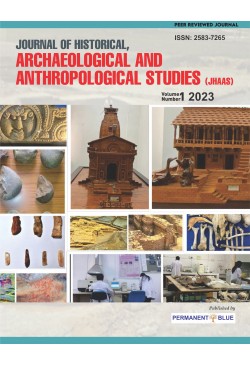
Journal of Historical, Archaeological and Anthropological Studies
Frequency :Bi-Annual
ISSN :2583-7265
Peer Reviewed Journal
Contents and Editorial Note:
The Origin and Growth of Maṭhas: Historical and Religious Context
Rao, N. 2023. The Origin and Growth of Maṭhas: Historical and Religious Context. Journal of Historical, Archaeological and Anthropological Studies, 1: 1, pp. 1-17.
New Discovery of Paleolithic Evidence in Dargaz Plain, Northeastern Iran
Sadraei, A., & Azar, M. 2023. New Discovery of Paleolithic Evidence in Dargaz Plain, Northeastern Iran. Journal of Historical, Archaeological and Anthropological Studies, 1: 1, pp. 19-33.
Analytical Study of Newly Discovered Rock Art Site at Panni Waterfall in Panna District, Central India, M.P.
Patel, D., Farswan, Y.S. & Raj, P. 2023. Analytical Study of Newly Discovered Rock Art Site at Panni Waterfall in Panna District, Central India, M.P.. Journal of Historical, Archaeological and Anthropological Studies, 1: 1, pp. 35-44.
Traditional Socio-cultural Wisdom on Indian Puranic Plants in the Present Context
Jain, V. 2023. Traditional Socio-cultural Wisdom on Indian Puranic Plants in the Present Context. Journal of Historical, Archaeological and Anthropological Studies, 1: 1, pp. 45-56.
Origin and Development of Science in India
The paper deals with the origin and development of science in the Indian subcontinent. How people started to observe nature and develop technologies for their betterment. Science is simply a systematic study of the natural and physical world through observation and experiment, whereas technology is defined as the application of knowledge in practice. As it can be seen in the subcontinent that the people of the Palaeolithic period were well aware of tool making, which involves different techniques, so it could be said that the beginning of science in the Indian subcontinent started from the Palaeolithic period itself and developed continuously from time to time.
Keywords: tool making, pottery, agriculture, domestication of animals, metallurgy, astronomy,
Raj, P., Farswan, Y.S. & Ahmed, N. 2023. Origin and Development of Science in India. Journal of Historical, Archaeological and Anthropological Studies, 1: 1, pp. 57-62.
Recent Investigation into the Probable Late Palaeolithic Rock-Art Sites in the Northern Bargarh Uplands, Odisha
Behera, P.K., & Barik, K. 2023. Recent Investigation into the Probable Late Palaeolithic Rock-Art Sites in the Northern Bargarh Uplands, Odisha. Journal of Historical, Archaeological and Anthropological Studies, 1: 1, pp. 63-80.